INTRODUCTION
Following the arrival of a grant from the people running the High Speed
2 Rail project it was decided to go ahead with improvements to
facilities within the church including a new toilet in the west tower
and a new servery in the north aisle. This meant the digging of a
lengthy trench through the churchyard, something we already had
experience with at Cropredy.
Below are the daily reports posted as the investigations were carried out.
DAY ONE
I made a brief
site visit to St. Peter’s this lunch time and talked to the team there.
Slabs had been lifted from roughly half of the tower floor and we were
able to take a preliminary look at what was going on underneath. The
slabs, which are quite thin, are not terribly ancient but they are
based on about 200mm of sandy make up above a what appears to be a dirt
floor which may be medieval in origin.
The WSI says,
‘once the slabs have been lifted the surface below will be examined and
if necessary cleaned by hand and any features uncovered will be
recorded ...'
So the plan is
that over the next day and a half the contractors will complete lifting
the slabs and removing the make-up layer to the specified depth which
will bring the level close to the early floor surface. They will be
keeping an eye out for and setting on side for me to take a look at any
material, bits of pottery or similar, which may help us date the
construction of the most recent floor. I will return on Friday around
1.30 p.m. to take a look at the exposed surface at which point I’ll
decide how much of the earlier floor to clean up prior to recording.
DAY TWO
Yesterday afternoon I spent time on site at St. Peter’s with the following results.
Tower floor.
The slabs and make up layer below have now been removed. The
contractors carefully set aside any artefacts they came across which
included some fragments of decorated floor tiles, clay pipe stems and
post-medieval pottery suggesting an 18th. or early 19th. century date
for the insertion of the flagged floor. Below the make up was a dirt
floor, almost certainly late-medieval in date from the fragments of
pottery recovered pressed into the surface. In places the dirt floor
had been patched with a screed of lime mortar. A central pit filled
with plaster fragments may be evidence for early building
operations. A lower level stone threshold to the east was also
uncovered which appears contemporary to the dirt floor. Approximately
75% of the tower floor was examined in the time available but as this
surface is not due to be further lowered no further investigation will
take place.
Churchyard
trench. Turf has been stripped from the trench revealing a significant
deposit of stone fragments, possibly remains of metalling for an
earlier path or perhaps the remains of an earlier churchyard wall. The
middle section seems to have a greater depth of topsoil whilst
closer to the church the hard clayey subsoil appears closer to the
surface. This may give an early indication of the location of possible
burials.
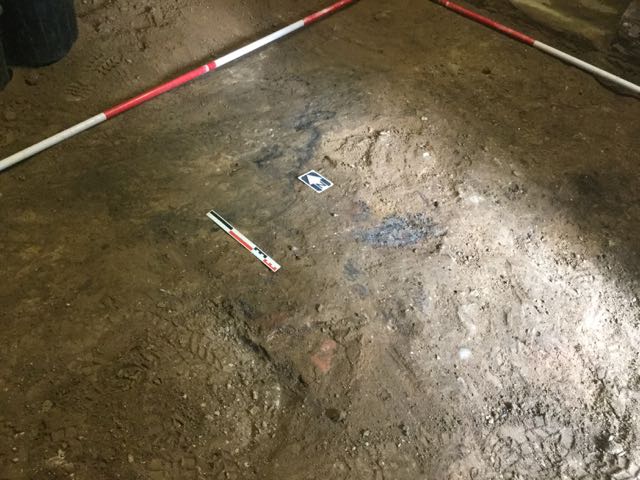
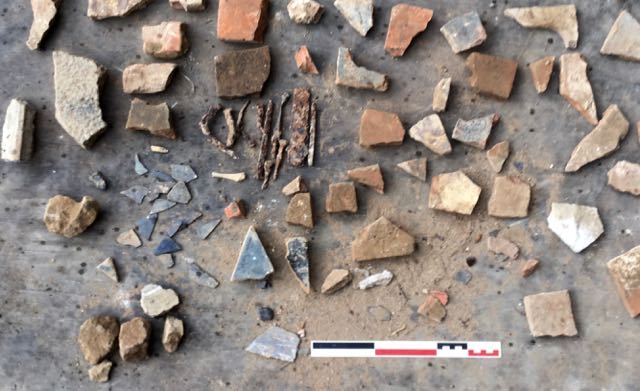
The tower floor, late medieval
dirt.
Artefacts recovered by the contractors in make up below the slabs

Turf stripped from the line of the ptpe trench.
DAY THREE
A very
productive session with the sun shining all day. A new trench was dug
firstly by digger and then by hand against the face of the north wall
of the north aisle with an extension to examine the footings for the
diagonal buttress on its north west corner. There were some very
interesting pieces of clearly reused stone built into the buttress
base. Round the corner the hole drilling through into the base of the
west tower proceeded apace. The trench dug out to allow access for the
drilling rig has not been examined but there is a very interesting
offset course which has hitherto been buried. A pit was dug by the
contractor on the inside of the tower revealing the fact that the wall
with good faced stones continues well below the last identified floor
level. Once the drilling is completed tomorrow I plan to clean and
examine and record both of these trenches. At the north end of the pipe
trench a deep pit was dug to a depth of around 2m. This showed us a
fairly undisturbed sequence of topsoil, subsoil, natural red clay and
natural red sand with no signs of human activity below topsoil level.
Tomorrow we also plan to begin the excavation of the 20m length of
trench from the tower to the northern boundary of the churchyard.
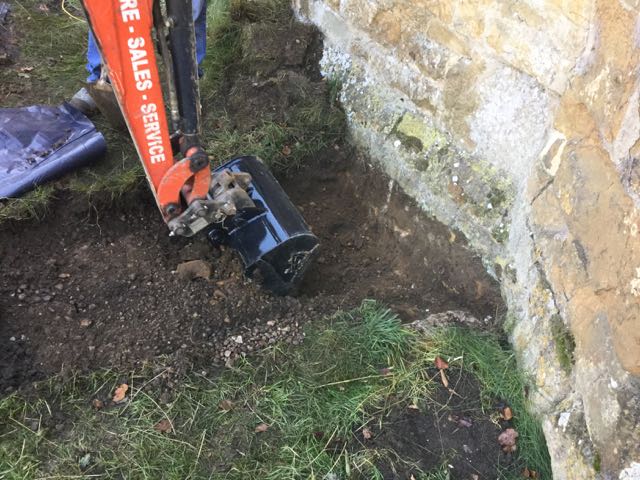
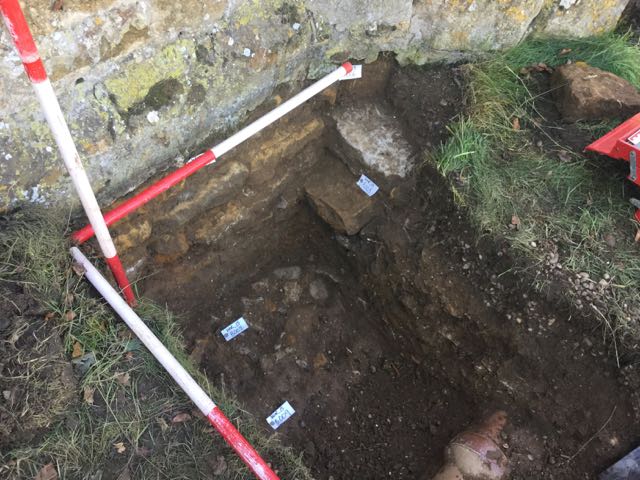
Excacavtions at the foot of the north aisle wall...
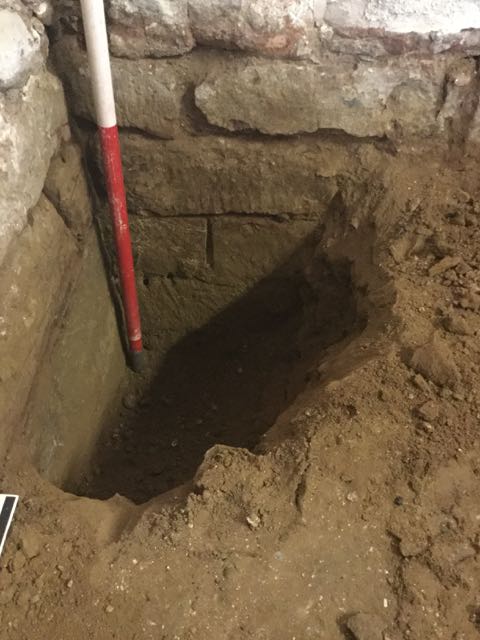
.. and in the north west corner inside the tower.
DAY FOUR
Well it had to
happen. an intact burial or two with maybe more to follow. I’ve
informed the incumbent, archdeacon and DAC as per the faculty and await
the archdeacon’s approval for work to continue, This is not a major
problem as I feel we can carry on digging out other sections of the
trench avoiding bones for now. What it does mean is the possibility of
extra days on site and some delay in the completion of this phase of
the work. I’ll know more about that by the end of play tomorrow. The
burial is not particularly deep and is probably therefore late
medieval. I believe the bones are of a juvenile or young adult
and the section we have is of the middle of the body with some ribs, a
forearm crossed over the stomach region and a very decayed pelvis.
Conditions for excavating the remains are quite challenging given the
narrowness and depth of the trench and the hardness of the ground plus
there is likely to be at least one more burial at a slightly higher
level immediately to the south and who knows what else.
Early in the
day we had cleared the topsoil using the 450mm toothless bucket from
pretty well the entire length of the trench in an attempt to identify
the location of specific graves or the remains of associated monuments.
No features were observed at this level and so I gave the go ahead to
deepen the trench in sections to its full depth. Because of the
prevalence of tree roots and a very solid red clay I authorized the use
of a toothed bucket to break up the ground before reverting to the
bladed bucket to scrape surfaces clean. Even so I was not surprised
that we didn't’t see any higher indications of the burial we
encountered, even knowing where it is now it is still hard to see the
grave cut into which the burial was inserted. Whilst I examined this
collection of bones the trench digging continued beyond that point at a
much higher level. One particularly interesting find that came out of
the sub-soil was a fragment of a shallow circular stone basin which I
think may be a section of a quern for grinding corn, possibly early
medieval or even pre-historic.
Up against the
church wall the drilling was completed through the wall into the base
of the west tower freeing me up to begin an investigation of its
footing. perhaps a little surprisingly the dressed face of the wall
with two chamfers continued down to a considerable depth. Meanwhile the
recording of the footings for the both aisle wall being completed the
drilling crew moved on to their and at the same time removed an area of
sobs in side the north west corner of the north aisle to receive the
incoming pipework, again this operation was recorded.

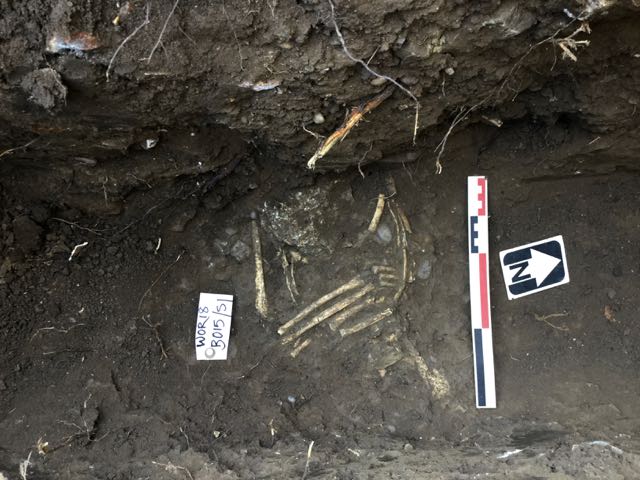
The deep pit for the inspection chamber cuts through layers of
natural.
The first burial, of a juvenile.
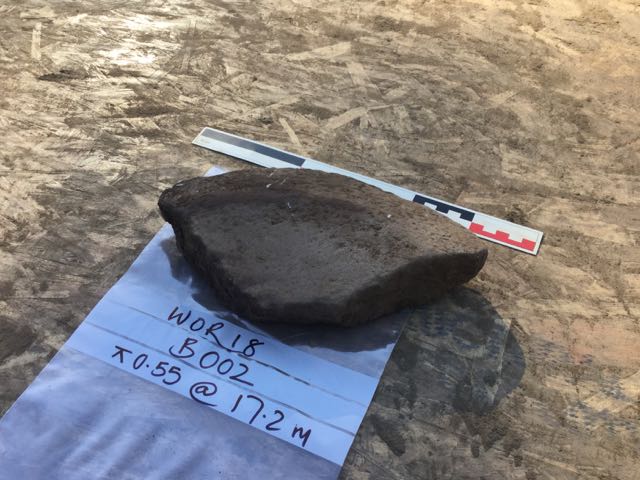
The stone bowl, a possible quern?
DAY FIVE
The day began
with a widening of the trench to a full 450mm to enable me to fit into
it a little more comfortably! Once in place some additional work was
done to establish the position and extent of the juvenile
skeleton before turning attention to the bone fragments observed
yesterday a short distance to the south. Once the loose had been
cleared it became clear that we had a skull and jawbone against the
west side of the trench. Working downwards from here during the course
of the morning this second skeleton was uncovered down to the base of
the rib cage. The bones, especially the vertebrae were in poor
condition, spongy and brittle perhaps indicating a medical condition of
some kind. Once cleaned up both burials were photographed and drawn
onto the master site plan. We were unable to proceed further as we need
to obtain authorisation from the archdeacon before lifting the bones.
Time was taken
to further excavate at the foot of the north wall of the west tower and
profiles, plans and sections were drawn here. Notes were also made of
the walling exposed in the deep pit cut into the inside corner of the
north aisle. It was also possible to record the full depth of the
foundations for the diagonal buttress on this corner which went down
far deeper than expected indicating perhaps how seriously the potential
for collapse on this corner was taken.
The contractors
had been mainly occupied with preparing the deep pit on the north edge
of the churchyard for the back drop inspection chamber. This meant that
it was not possible to further excavate the pipe trench so a more
detailed assessment of the density of burials remains to be done
tomorrow.
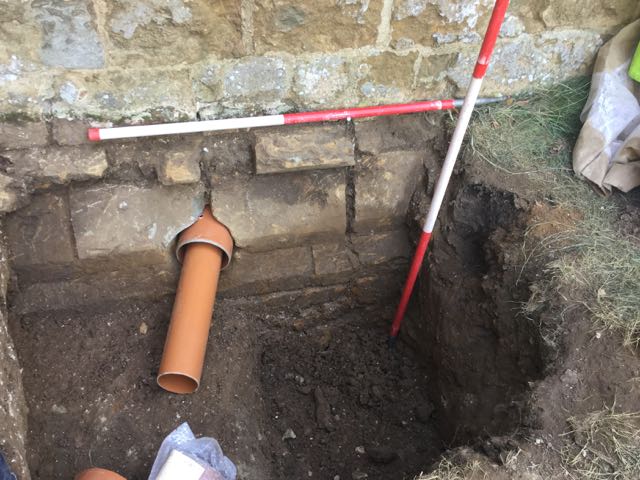
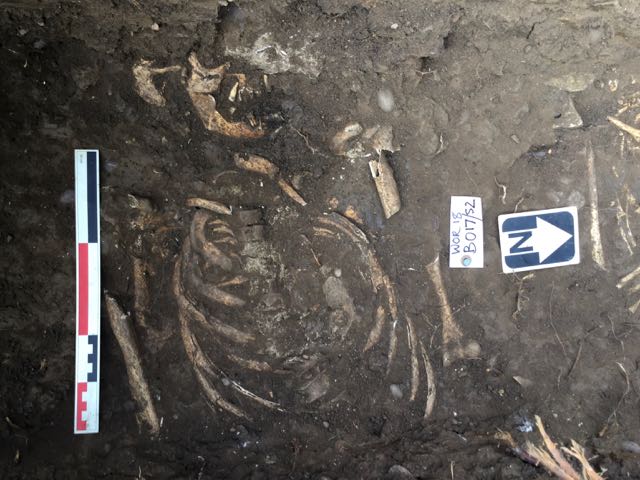
The tower footings
revealed.
Detail of skeleton number 2.
DAY SIX
Four new
interments bringing our total up to six at present. We spent the day
coming close to completion of the main pipe trench using a combination
of bladed and toothed buckets according to conditions. The first new
burial, skeleton 3, was remarkably close to the surface, around 500mm
and consisted of the lower right arm, pelvis and both femurs. The
second burial of the day was significantly deeper with the skull
appearing around 700mm down with the upper arms and chest being deeper
still, close to the intended depth for the bottom of the trench. The
skull suffered some damage from the digger but was already in a
fragmentary state. Cleaning this up took most of the afternoon as it
was packed around with hard clay all of which had to be carefully
removed by trowel and palette knife. A couple of pieces of clay pipe
steam, were in the fill of this grave indicating it is post-medieval,
perhaps this accounts for the extra depth. The remaining two burials
have been identified but not yet cleaned. These together with the
others have been covered over with black polythene and planks and ply
sheeting.
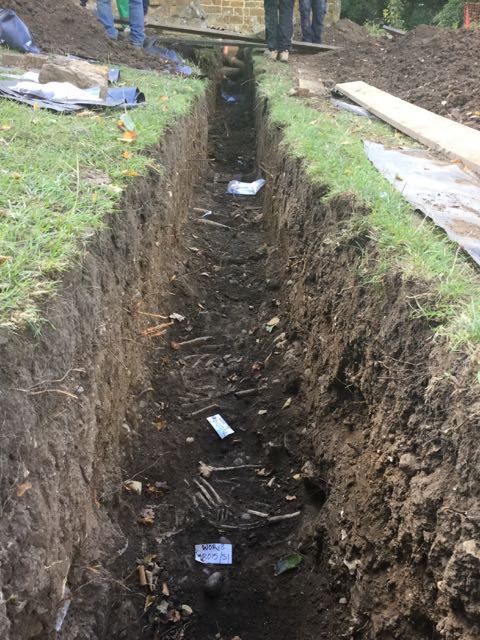
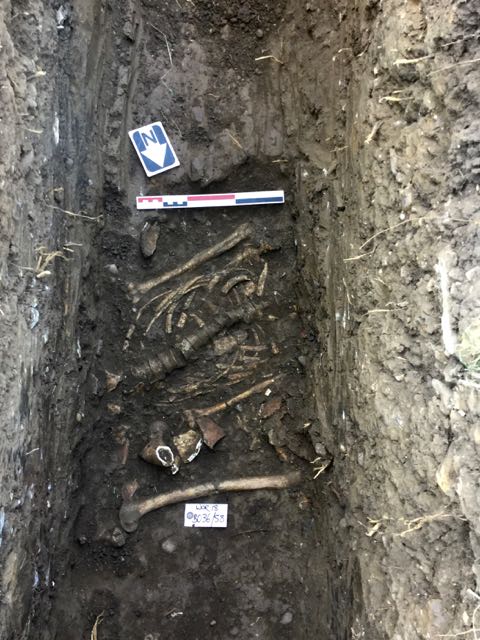
More burials appear along the length of the trench.
DAY SEVEN
Over to my
store at Hanwell first thing to pick up the necessaries for mass
skeleton lifting and storing. Back at Wormleighton a day to pretty well
finish off the pipe trench including its extension to the north wall of
the north aisle. A start was made on lifting the bones identified and
recorded earlier in the week. Unfortunately, as I rather suspected
given the shallow nature of the first round of interments we have
secondary burials at a lower level but still high enough to need
removal. Together with other new burials towards the south end of the
trench we have something of a sea of bones with nine intact burials
demanding attention. I am fairly confident that at most there might be
one or two more but my plan is to work Saturday morning and all day
Sunday to clean, record and lift these burials. As I said yesterday my
plan to to have the site cleared by Monday morning for David and his
team to start pipe laying.
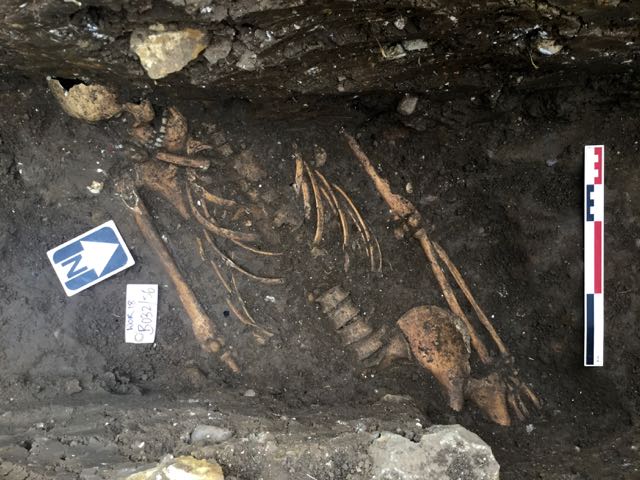
This one was closest to the church and was probably coffined.
DAY EIGHT
Not a huge
amount to report from this morning’s session, three more graves cleared
of bones which are now bagged up and stored in church. A new grave
spotted yesterday proved very interesting, comparatively well preserved
bones but with the joy of added extra charnel: additional bones
obviously disturbed whilst the new grave was being dug and then popped
back into the ground with the new interment. These things are
complicated to dig as you never quite know what’s coming up next. The
other complication is discovering lower burials below the higher ones
already excavated and removed. This was the case with Skeleton 4, once
out of the way a couple of toe bones appeared where no toe bones should
be and a little further excavation revealed a pair of feet and
accompanying leg bones I’ll need to finish off cleaning this
tomorrow. They lie right on the 800mm mark and may not need lifting. I
also as a alternative to peering at bones cleaned up the lower
courses of the corner buttress. The foundations are really quite
impressive. For tomorrow I have three burials to excavate, record and
lift which should be doable providing no other customers emerge.
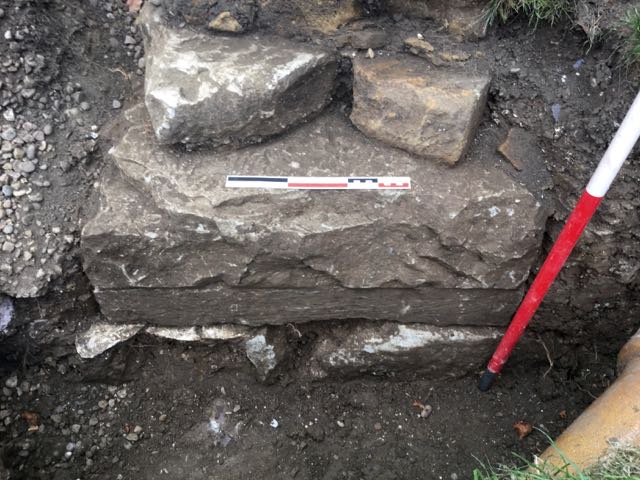
The extraordinary stone, part of the foundation for the diagonal buttress.
DAY NINE
So the last day
of digging, at least as far as the archaeology is concerned.. Further
examination of the bottom of the trench took our total of burials up to
12 and I suspect that that is roughly half the full number of
interments in our patch, however, as we have no remit to dig deeper
we’ll never know. Of particular interest was skeleton 6, the one
nearest to church which although quite shallow was almost certainly
coffined. the good state of preservation of the bones with lack of
crushing and the position of the arms away from and parallel to the
body all suggest this. A little further down the trench the legs of
skeleton 9 projected across the junction between the main trench and
the one to the north aisle. this particular individual had had the
right femur chopped through and not by us. In fact it became clear that
a later, and much deeper grave had been dug to the south east and in
the fill of that grave, the missing portion of femur, dropped back in
when it was filled. The skull of skeleton 10 was particularly well
preserved but as this was nearly a metre down there was no need to to
lift it and after recording it was filled back in. Almost at the other
end of the trench a final clean up of skeleton 8 revealed that the
femur lying next to it was not charnel (assorted bones gathered
together and reburied ) but was the surviving remnant of another burial
which again had been truncated by a later gave cut . I took another
look at the foundation block for the buttress and was surprised to note
that there was a single huge half dressed block which had clearly been
reused and turned over. Thanks to Michael Abbott who dropped by and
helped me with final set of levels and Verna who helped with the big
clear up and Sheila who unlocked for the last few bones to be safely
stored in church.
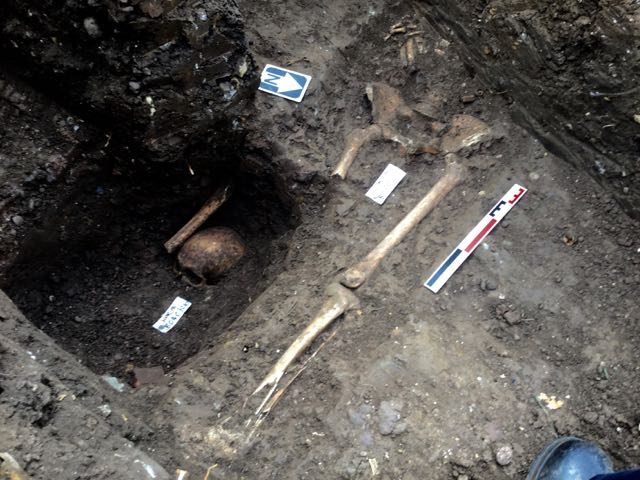
A later, deeper burial cutting through a higher earlier one.
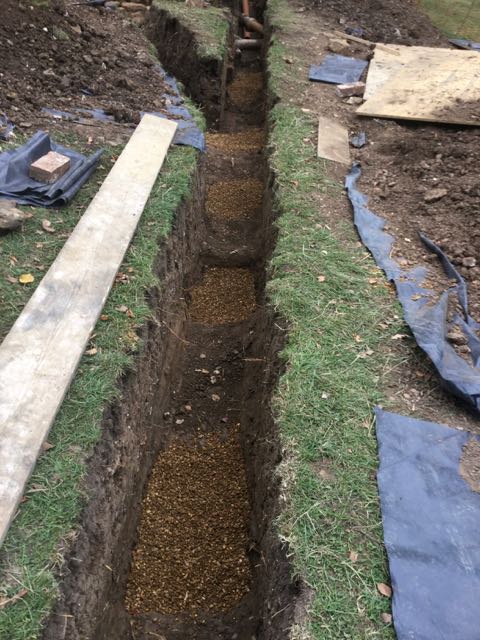
The burials filled in and covered over.
 St. Peter's, Wormleighton- The Churchyard Dig
St. Peter's, Wormleighton- The Churchyard Dig 
 St. Peter's, Wormleighton- The Churchyard Dig
St. Peter's, Wormleighton- The Churchyard Dig 
















